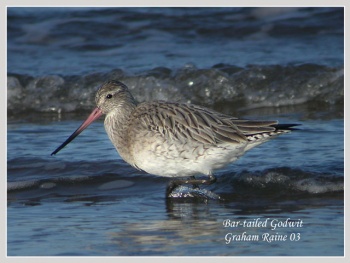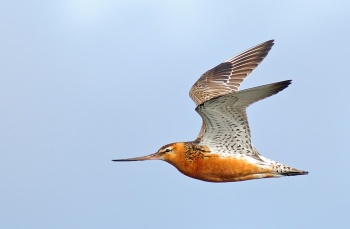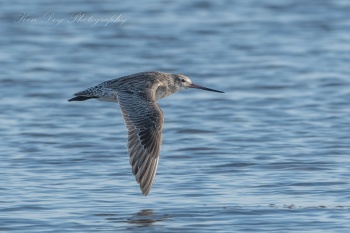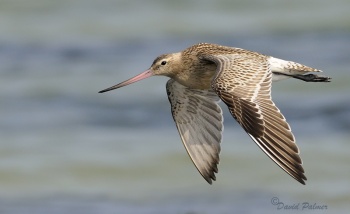(Taxonomy expanded. Picture details added) |
(taxon) |
||
| (32 intermediate revisions by 7 users not shown) | |||
| Line 1: | Line 1: | ||
| − | [[Image: | + | [[Image:barwit_breeding.jpg|thumb|550px|right|Adult summer nominate ''L. l. lapponica''<br />Photo © by {{user|postcardcv|postcardcv}}<br />[[Titchwell Marsh]], [[Norfolk]], 9 August 2006]] |
;[[:Category:Limosa|Limosa]] lapponica | ;[[:Category:Limosa|Limosa]] lapponica | ||
==Identification== | ==Identification== | ||
| − | In ''' | + | [[Image:Bar-tailed_Godwit.jpg|thumb|350px|right|Adult winter nominate ''L. l. lapponica''<br />Photo © by {{user|Ragna|Graham Raine}}<br />[[Titchwell Marsh]], [[Norfolk]], 30 November 2003]] |
| − | In ''' | + | 37–41 cm (14½-16 in)<br /> |
| − | In ''' | + | In '''breeding''' plumage: belly rufous with no or little barring, upperparts dark, and bill slightly upturned, dark with paler base.<br /> |
| + | In '''non-breeding''' plumage: breast finely streaked grey, belly whitish, back grey with streaking, bill bicoloured with pink base, and long supercilium extending back past eye.<br /> | ||
| + | In '''juvenile''' plumage: breast pale buff-grey, back patterned with white and buffy-grey, upturned bill bicoloured, and long supercilium extending back past eye.<br /> | ||
| + | In '''flight''': inner wings grey, outer wing dark grey; no wingbar. Tail finely barred grey. Rump and lower back white or grey, depending on subspecies. | ||
| + | ====Variation==== | ||
| + | Western birds (more or less the first three subspecies) have white on rump, lower back and underwing; subspecies from further east have barring on these areas with the ones from eastern Siberia and Alaska strongly barred grey. | ||
====Similar Species==== | ====Similar Species==== | ||
| − | [[Black-tailed Godwit]], which has a straighter bill; and from [[Eurasian Curlew]] and [[Whimbrel]] which both have down-curved beaks. | + | [[Black-tailed Godwit]], which has a straighter bill, solid black tail tip, and strong white wingbar (see comparison image<sup>[[#References|[1]]]</sup>); and from [[Eurasian Curlew]] and [[Whimbrel]] which both have down-curved beaks. |
==Distribution== | ==Distribution== | ||
| − | [[Image: | + | [[Image:bar_tailed_godwit_alok.JPG|thumb|350px|right|Subspecies ''L. l. taymyrensis'', wintering at west coast of India; other birds seen are Lesser Sand Plover and Terek Sandpiper<br />Photo © by {{user|aloktewari|Alok Tewari}}<br />Jamnagar, Gujarat, [[India]], 19 December 2017]] |
| − | *Breeds in northern [[Palearctic]]: extreme northern [[Scandinavia]] ([[Norway]], [[Finland]], limited in [[Sweden]]), | + | *Breeds in northern [[Palearctic]]: extreme northern [[Scandinavia]] ([[Norway]], [[Finland]], limited in [[Sweden]]), Arctic [[Russia]] (Kola Peninsula eastwards), and [[Alaska]]. |
| − | *Migration most active March | + | *Migration most active March to early June (south to north), and August-October (north to south). Seen regularly en route through the Baltic Sea, North Sea, and Atlantic coasts. Rare to find any distance inland. |
| − | *Winters to southern [[Africa]] and [[Australasia]]. | + | *Winters to southern [[Africa]] and [[Australasia]]. Immature birds (one year old) often remain in the wintering range for their entire first summer. |
====Vagrancy==== | ====Vagrancy==== | ||
| − | Vagrant north to [[Svalbard]], [[Iceland]] and the [[Faroe Islands]]; [[Cyprus]] and eastern [[Mediterranean]] countries; [[Madeira]] and the [[Azores]]. | + | Vagrant north to [[Svalbard]], [[Iceland]] and the [[Faroe Islands]]; [[Cyprus]] and eastern [[Mediterranean]] countries; [[Madeira]] and the [[Azores]]. Casual vagrant in [[North America]] on both coasts. |
| − | Casual vagrant in [[North America]] on both coasts. | + | |
==Taxonomy== | ==Taxonomy== | ||
| − | + | ====Subspecies==== | |
| − | + | ||
| − | ====Subspecies<sup>[[#References|[1]]]</sup> | + | Five subspecies currently accepted<sup>[[#References|[1]]]</sup>: |
| − | *''L. l. lapponica'': | + | *''L. l. lapponica'': |
| − | :* | + | :*breeds from northern [[Scandinavia]] east to the Kanin Peninsula (northwestern [[Russia]]); winters from the North Sea, western [[Iberia]], and northwestern [[Africa]] south to western [[South Africa]] |
| − | *''L. l. | + | *''L. l. yamalensis'': |
| − | :* | + | :*Breeds on the northern West-Siberian Plain, including the Yamal Peninsula and the lower Ob River Valley; winter range incompletely known, but extends from [[Oman]] east to western [[India]], and probably the east coast of [[Africa]], perhaps south to [[South Africa]] |
| − | *''L. l. | + | *''L. l. taymyrensis'': |
| − | :* | + | :*Breeds north central Siberia, roughly from the lower Yenisei River Valley east to the lower Anabar River Valley; winter range incompletely known but primarily coasts of West [[Africa]] |
| + | *''L. l. menzbieri'': | ||
| + | :*Northern Siberia; winters south-east Asia to coastal [[Australia]], [[Tasmania]] (included in ''L. l. baueri'' by some authors). | ||
| + | *''L. l. anadyrensis'': | ||
| + | :*breeds eastern [[Siberia]] (Chukotka and Anadyr lowlands); winters in [[Australia]], possibly also [[New Zealand]] | ||
| + | *''L. l. baueri'': | ||
| + | :*North-eastern Siberia to western [[Alaska]]; winters coastal [[China]] to [[New Zealand]]. | ||
| + | |||
==Habitat== | ==Habitat== | ||
| + | [[Image:Myrspov2.jpg|thumb|350px|right|Breeding plumage<br />Photo © by {{user|Digiscoper321|Digiscoper321}}<br />West [[Sweden]], 5 July 2016]] | ||
| + | |||
*Coastal estuaries and sheltered sandy shores. | *Coastal estuaries and sheltered sandy shores. | ||
*Arctic breeding habitat is lowland tundra; sometimes in upland areas and among trees. | *Arctic breeding habitat is lowland tundra; sometimes in upland areas and among trees. | ||
| + | |||
==Behaviour== | ==Behaviour== | ||
| + | A very strong migrant; ''L. l. baueri'' makes the longest non-stop flights of any bird, over 11,500 km from [[Alaska]] to [[New Zealand]] during autumn migration (but two stages on spring migration, with a stop-over on the east coast of [[China]])<sup>[[#References|[4]]]</sup>. | ||
| + | |||
Very gregarious in the winter, forming huge flocks with other waders at the water's edge. | Very gregarious in the winter, forming huge flocks with other waders at the water's edge. | ||
====Diet==== | ====Diet==== | ||
The diet includes worms, snails and insects. | The diet includes worms, snails and insects. | ||
====Breeding==== | ====Breeding==== | ||
| + | [[Image:Bar-tailed Godwit 2-1.jpg|thumb|350px|right|Subspecies ''menzbieri''<br />Photo © by {{user|Ken+Doy|Ken Doy}}<br />Wellington Point, Brisbane, [[Queensland]], January 2019]] | ||
It nests on the ground, usually in short vegetation, in marshy areas above the tree-line. | It nests on the ground, usually in short vegetation, in marshy areas above the tree-line. | ||
| − | ===Vocalisation=== | + | ====Vocalisation==== |
| − | + | {{Audio|Limosa lapponica (song).mp3}} | |
| − | ''[[ | + | |
| + | ==Gallery== | ||
| + | [[Image:BARTGODWIT019.jpg|thumb|350px|right|Juvenile ''L. l. lapponica''<br /> Photo © by {{user|I4ani|I4ani}}<br />Brignogan Plage, Brittany, [[France]], September 2008]] | ||
| + | Click images to see larger version | ||
| + | <gallery> | ||
| + | Image:bar_tailed_godwit_2_alok.JPG|Subspecies ''L. l. taymyrensis'' showing tail-bars<br />By {{user|aloktewari|Alok Tewari}}<br />Jamnagar, West Coast, Gujarat , [[India]], 19 December 2017 | ||
| + | Image:IMG 20190511 224716.jpg|[[Bar-tailed Godwit]] left, [[Black-tailed Godwit]] right <br />Photo © by {{user|Andy+Hall|Andy Hall}}<br /> Texel, Netherlands, 11 May 2019 | ||
| + | </gallery> | ||
==References== | ==References== | ||
| − | #{{Ref- | + | #{{Ref-Clements6thOct22}}#{{Ref-GillDonskerRasmussen22V12.2}}#{{Ref-HBWVol3}}#Gill, R. E., Tibbitts, T. L., Douglas, D. C., Handel, C. M., Mulcahy, D. M., Gottschalck, J. C., Warnock, N., McCaffery, B. J., Battley, P. F., & Piersma, T. (2008). Extreme endurance flights by landbirds crossing the Pacific Ocean: ecological corridor rather than barrier? ''Proc Biol Sci''. [http://alaska.usgs.gov/science/biology/avian_influenza/pdfs/Gill_et_al_2008_Godwit_Migration.pdf 276 (1656): 447–457]. |
| − | # | + | #BirdLife International. 2016. ''Limosa lapponica''. The IUCN Red List of Threatened Species 2016: e.T22693158A93386492. http://dx.doi.org/10.2305/IUCN.UK.2016-3.RLTS.T22693158A93386492.en. Downloaded on 26 March 2017. |
| − | # | + | #Gerard Hutching, 'Wading birds - Bar-tailed godwits', Te Ara - the Encyclopedia of New Zealand, http://www.TeAra.govt.nz/en/wading-birds/page-7 (accessed 26 March 2017) |
| − | # | + | #McCaffery, Brian J. and Robert E. Gill. (2001). Bar-tailed Godwit (''Limosa lapponica''), The Birds of North America (P. G. Rodewald, Ed.). Ithaca: Cornell Lab of Ornithology; Retrieved from the Birds of North America: https://birdsna.org/Species-Account/bna/species/batgod DOI: 10.2173/bna.581 |
| + | #Piersma, T., Lok, T., Chen, Y., Hassell, C. J., Yang, H.-Y., Boyle, A., Slaymaker, M., Chan, Y.-C., Melville, D. S., Zhang, Z.-W. and Ma, Z. (2016), Simultaneous declines in summer survival of three shorebird species signals a flyway at risk. J Appl Ecol, 53: 479ñ490. doi:10.1111/1365-2664.12582 | ||
| + | #Van Gils, J., Wiersma, P., Sharpe, C.J. & Boesman, P. (2017). Bar-tailed Godwit (''Limosa lapponica''). In: del Hoyo, J., Elliott, A., Sargatal, J., Christie, D.A. & de Juana, E. (eds.). Handbook of the Birds of the World Alive. Lynx Edicions, Barcelona. (retrieved from http://www.hbw.com/node/53890 on 26 March 2017). | ||
| + | #Woodley, K. 2013. Bar-tailed godwit in Miskelly, C.M. (ed.) New Zealand Birds Online. www.nzbirdsonline.org.nz | ||
| + | #Fitter, R.S.R. & Richardson, R.A. (1966). Pocket Guide to British Birds. London: Collins. | ||
| + | #{{Ref-Collins5th93}}#{{Ref-Grantetal99}}#[http://www.arthurgrosset.com/europebirds/bar-tailedgodwit.html Arthur Grosset's Birds] | ||
{{ref}} | {{ref}} | ||
| + | |||
==External Links== | ==External Links== | ||
| − | {{GSearch|Limosa | + | {{GSearch|"Limosa lapponica" {{!}} "Bar-tailed Godwit"}} |
| + | {{GS-checked}} | ||
| + | <br /> | ||
| + | <br /> | ||
[[Category:Birds]][[Category:Limosa]] [[Category:Bird Songs]] | [[Category:Birds]][[Category:Limosa]] [[Category:Bird Songs]] | ||
Latest revision as of 00:56, 8 March 2023
- Limosa lapponica
Identification

Photo © by Graham Raine
Titchwell Marsh, Norfolk, 30 November 2003
37–41 cm (14½-16 in)
In breeding plumage: belly rufous with no or little barring, upperparts dark, and bill slightly upturned, dark with paler base.
In non-breeding plumage: breast finely streaked grey, belly whitish, back grey with streaking, bill bicoloured with pink base, and long supercilium extending back past eye.
In juvenile plumage: breast pale buff-grey, back patterned with white and buffy-grey, upturned bill bicoloured, and long supercilium extending back past eye.
In flight: inner wings grey, outer wing dark grey; no wingbar. Tail finely barred grey. Rump and lower back white or grey, depending on subspecies.
Variation
Western birds (more or less the first three subspecies) have white on rump, lower back and underwing; subspecies from further east have barring on these areas with the ones from eastern Siberia and Alaska strongly barred grey.
Similar Species
Black-tailed Godwit, which has a straighter bill, solid black tail tip, and strong white wingbar (see comparison image[1]); and from Eurasian Curlew and Whimbrel which both have down-curved beaks.
Distribution

Photo © by Alok Tewari
Jamnagar, Gujarat, India, 19 December 2017
- Breeds in northern Palearctic: extreme northern Scandinavia (Norway, Finland, limited in Sweden), Arctic Russia (Kola Peninsula eastwards), and Alaska.
- Migration most active March to early June (south to north), and August-October (north to south). Seen regularly en route through the Baltic Sea, North Sea, and Atlantic coasts. Rare to find any distance inland.
- Winters to southern Africa and Australasia. Immature birds (one year old) often remain in the wintering range for their entire first summer.
Vagrancy
Vagrant north to Svalbard, Iceland and the Faroe Islands; Cyprus and eastern Mediterranean countries; Madeira and the Azores. Casual vagrant in North America on both coasts.
Taxonomy
Subspecies
Five subspecies currently accepted[1]:
- L. l. lapponica:
- breeds from northern Scandinavia east to the Kanin Peninsula (northwestern Russia); winters from the North Sea, western Iberia, and northwestern Africa south to western South Africa
- L. l. yamalensis:
- Breeds on the northern West-Siberian Plain, including the Yamal Peninsula and the lower Ob River Valley; winter range incompletely known, but extends from Oman east to western India, and probably the east coast of Africa, perhaps south to South Africa
- L. l. taymyrensis:
- Breeds north central Siberia, roughly from the lower Yenisei River Valley east to the lower Anabar River Valley; winter range incompletely known but primarily coasts of West Africa
- L. l. menzbieri:
- L. l. anadyrensis:
- breeds eastern Siberia (Chukotka and Anadyr lowlands); winters in Australia, possibly also New Zealand
- L. l. baueri:
- North-eastern Siberia to western Alaska; winters coastal China to New Zealand.
Habitat
- Coastal estuaries and sheltered sandy shores.
- Arctic breeding habitat is lowland tundra; sometimes in upland areas and among trees.
Behaviour
A very strong migrant; L. l. baueri makes the longest non-stop flights of any bird, over 11,500 km from Alaska to New Zealand during autumn migration (but two stages on spring migration, with a stop-over on the east coast of China)[4].
Very gregarious in the winter, forming huge flocks with other waders at the water's edge.
Diet
The diet includes worms, snails and insects.
Breeding
It nests on the ground, usually in short vegetation, in marshy areas above the tree-line.
Vocalisation
Gallery
Click images to see larger version
Subspecies L. l. taymyrensis showing tail-bars
By Alok Tewari
Jamnagar, West Coast, Gujarat , India, 19 December 2017Bar-tailed Godwit left, Black-tailed Godwit right
Photo © by Andy Hall
Texel, Netherlands, 11 May 2019
References
- Clements, J. F., T. S. Schulenberg, M. J. Iliff, T. A. Fredericks, J. A. Gerbracht, D. Lepage, S. M. Billerman, B. L. Sullivan, and C. L. Wood. 2022. The eBird/Clements checklist of Birds of the World: v2022. Downloaded from https://www.birds.cornell.edu/clementschecklist/download/
- Gill, F, D Donsker, and P Rasmussen (Eds). 2022. IOC World Bird List (v 12.2) DRAFT. Doi 10.14344/IOC.ML.12.2. http://www.worldbirdnames.org/
- Del Hoyo, J, A Elliot, and J Sargatal, eds. 1996. Handbook of the Birds of the World. Volume 3: Hoatzin to Auks. Barcelona: Lynx Edicions. ISBN 978-8487334207
- Gill, R. E., Tibbitts, T. L., Douglas, D. C., Handel, C. M., Mulcahy, D. M., Gottschalck, J. C., Warnock, N., McCaffery, B. J., Battley, P. F., & Piersma, T. (2008). Extreme endurance flights by landbirds crossing the Pacific Ocean: ecological corridor rather than barrier? Proc Biol Sci. 276 (1656): 447–457.
- BirdLife International. 2016. Limosa lapponica. The IUCN Red List of Threatened Species 2016: e.T22693158A93386492. http://dx.doi.org/10.2305/IUCN.UK.2016-3.RLTS.T22693158A93386492.en. Downloaded on 26 March 2017.
- Gerard Hutching, 'Wading birds - Bar-tailed godwits', Te Ara - the Encyclopedia of New Zealand, http://www.TeAra.govt.nz/en/wading-birds/page-7 (accessed 26 March 2017)
- McCaffery, Brian J. and Robert E. Gill. (2001). Bar-tailed Godwit (Limosa lapponica), The Birds of North America (P. G. Rodewald, Ed.). Ithaca: Cornell Lab of Ornithology; Retrieved from the Birds of North America: https://birdsna.org/Species-Account/bna/species/batgod DOI: 10.2173/bna.581
- Piersma, T., Lok, T., Chen, Y., Hassell, C. J., Yang, H.-Y., Boyle, A., Slaymaker, M., Chan, Y.-C., Melville, D. S., Zhang, Z.-W. and Ma, Z. (2016), Simultaneous declines in summer survival of three shorebird species signals a flyway at risk. J Appl Ecol, 53: 479ñ490. doi:10.1111/1365-2664.12582
- Van Gils, J., Wiersma, P., Sharpe, C.J. & Boesman, P. (2017). Bar-tailed Godwit (Limosa lapponica). In: del Hoyo, J., Elliott, A., Sargatal, J., Christie, D.A. & de Juana, E. (eds.). Handbook of the Birds of the World Alive. Lynx Edicions, Barcelona. (retrieved from http://www.hbw.com/node/53890 on 26 March 2017).
- Woodley, K. 2013. Bar-tailed godwit in Miskelly, C.M. (ed.) New Zealand Birds Online. www.nzbirdsonline.org.nz
- Fitter, R.S.R. & Richardson, R.A. (1966). Pocket Guide to British Birds. London: Collins.
- Peterson, RT, G Mountfort and PAD Hollom. 1993. Collins Field Guide – Birds of Britain and Europe, 5th Revised edition. London: HarperCollins Publishers. ISBN 978-0002199001
- Grant, P.J., K. Mullarney, L. Svensson, D. Zetterstrom (1999) Collins Bird Guide: The Most Complete Field Guide to the Birds of Britain and Europe. Harpercollins Pub Ltd ISBN 0 00 219728 6
- Arthur Grosset's Birds
Recommended Citation
- BirdForum Opus contributors. (2024) Bar-tailed Godwit. In: BirdForum, the forum for wild birds and birding. Retrieved 3 May 2024 from https://www.birdforum.net/opus/Bar-tailed_Godwit
External Links
GSearch checked for 2020 platform.









